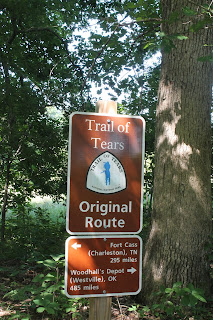How
do you celebrate Independence Day? My way of commemorating American history was
to visit one of the sites that have preserved the memory of the Trail of Tears,
a shameful chapter in American history. Americans tend to forget about the dark
side of their history during all of the fireworks, beer, and bloody barbecues.
The
Cherokee Tribe keeps alive the memory of the Trail of Tears. In 1838, the
federal government under Andrew Jackson (the president so highly esteemed by
Donald Trump) forced nearly the entire Cherokee tribe to abandon their homes
and lives in eastern Tennessee and adjacent regions and walk (a few rode in
wagons) to what is now Oklahoma. One of these many thousands of Cherokees was my
great-great-great-grandmother Elizabeth Hildebrand Pettit, who came with her
children on the Hildebrand route of the Trail of Tears. They camped for a
couple of very cold weeks in winter at a place called Mantle Rock, waiting for
the Ohio River to open up enough for the ferry to take them to Illinois where
they continued their journey. I regularly visit Elizabeth’s grave, and have now
visited Mantle Rock.
The
Cherokees like to talk of the Trail of Tears as a Cherokee experience, although
Chickasaws, Choctaws, Muskogees, and Seminoles also had their Trails of Tears
to Oklahoma. Indeed, similar stories can be told for the approximately five
hundred Native tribes. We do not think of the United States as causing the
forced marches of refugees, but that is a part of our history, even though an
Oklahoma congressman recently referred to the Trail of Tears as a voluntary
walk. We pretend we are the land of the free and the home of the brave. We are,
for rich white people, which included most of my ancestors. But not for black
slaves. And not for Elizabeth, or her daughter Minerva, who married my great
great grandfather Lewis Hicks.
I
have posted a video about Mantle Rock, where I explain (in Darwin persona) that
human nature has elements of good and evil. We have evolved to be good to those
inside our group and evil to those outside. The inside group might be our tribe
or our religion. Through human history, we have expanded the boundary outward,
to include more people in the inside group: first whole countries, then lots of
countries (such as the failed League of Nations or the current European Union),
the whole world (the United Nations), and some people even include non-human
animals or whole ecosystems.
But
in recent years, many nations (most notably America) have retracted the
boundary. Many Americans now consider those from outside their country to be
unworthy of the most basic human dignity, and those outside their party (or
even their extreme faction in their party) to be unworthy of any respect. We
are rapidly retreating backwards in history in this particular way. Evolution has
given us the ability to expand the boundary between “us” and “them” outward,
but we are pulling it back inward.
This
is what I am thinking about this Independence Day.
Today,
millions of refugees are forced from their homes to places that do not welcome
them. The United States is one of the countries that does not welcome them. If
their skin is dark, there is practically no way they can enter as refugees. We
continue to welcome white refugees.
Back
in the 1980s Tulsa welcomed a bunch of Burmese refugees from the Zomi tribe. I
am a minority in their neighborhood. Good neighbors! But that was a long time
ago.
The
video is on my YouTube channel.
I
post below some of the images of Mantle Rock, a hauntingly beautiful place now
maintained by the Nature Conservancy.
Here is the original Trail:
Here
is a photo of Berry’s Ferry, the location where the Hildebrand contingent
finally crossed the Ohio River.










No comments:
Post a Comment